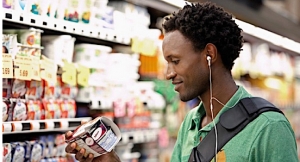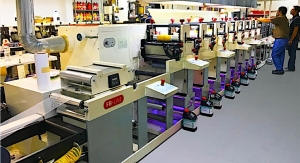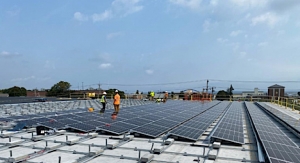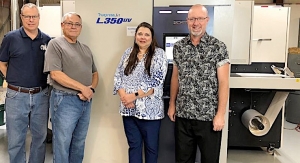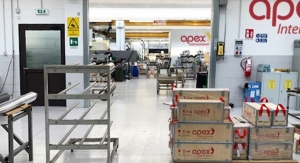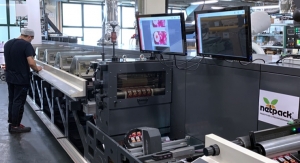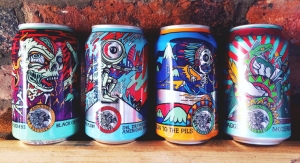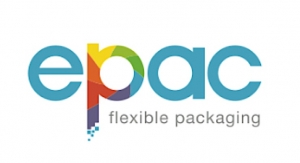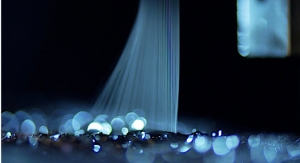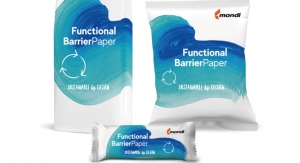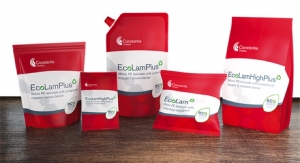Wallace Nard, President/owner of KYMC America08.20.18
There is a big culture change for label converters or commercial printers to move into flexible packaging. The big issue is printing and laminating to comply with indirect food applications. Flexible packaging requires specialized equipment, such as laminators, slitters or pouch machines, to compete effectively.
Today’s label sector is poised to look at other label and packaging solutions to generate new business. The focus is on value-added returns in order to serve existing customers or expand their market reach. Many specialty label converters have turned to developing quality products for specialty markets, and they have been very successful with this approach. Is it then reasonable to consider a new flexo press approach that can be configured for both flexible packaging and shrink sleeves?
Commodity vs Value Added
The narrow web label market has seen major shifts with digital and inkjet technologies for labels, but when entering the flexible packaging market, there is a need to evaluate the right equipment for various run lengths. The big question is how is it possible for narrow web converters to profitably gain a foothold in flexible packaging markets with a press designed to do labels? The answer is there will be limited penetration. Some segments of flexible packaging have become a commodity business with low margins.
Combine this with multiple SKU’s and shorter runs: The cost to compete has become a changing landscape. Some printer/converters have looked to "value-added" as a way to improve margins. The ability to stand out in the crowded grocery aisles gives Consumer Products Companies added value. However, there is another change in the wind with e-commerce and online grocery sales that are predicted to capture 20% of total grocery sales by 2025.
According to a recent study from the Association for Packaging and Processing Technologies, e-commerce sales jumped by 16% in 2016 alone. This will become the next major sector to become
disruptive as the numbers keep growing.
Amazon and Walmart models are where packages could very well be designed, especially for home delivery in custom formats and with promotional offerings. Some packages will be designed to be less prone to leaking and damage with home delivery. It is questionable if it is worth the cost to stock different SKUs for different channels, especially since some packages and labels are becoming more complex. This is very fluid at this point and yet to be determined.
There will still be the need for packages with long shelf-life and food safety preservation with some products. Also the need for packages in the grocery aisle competing with
each other and impulse buying will still be a player in the market. In addition, Dollar/General shoppers require smaller portion packages, whereas clubs sell in bulk.
The global flexible packaging market continues to evolve as shifts in consumer preference lean more toward convenience in single serve or grab-n-go options, extended shelf life, and sustainability. In addition to consumers driving innovation in flexible packaging, participation of wide web and now narrow web converters are beginning to converge into the packaging space as they see increased opportunity in equipment and coating technologies, thereby lowering the barrier-to-entry. With the label market slated to grow only 2% annually and flexible packaging at a strong 5%, there is even more reason for a company to acquire adjacent technologies or competitors to complement their business strategy.
How the package is printed?
HD Flexo and expanding use of Extended Gamut/G7 implementation has gained a great deal of interest, but this will require a different level of discipline and workflow. Some say this can reduce print costs when fully implemented, however there is still a big divide with many staying with spot colors or a combination of both.
Digital printing has also become a disruptive force, further segmenting certain areas of packaging and labels with short runs and promotional offerings. All these disruptive forces will bring about changes in how printer/converters meet these challenges and will alter the printing press needed to compete in each area in order to remain profitable. So, you have to ask yourself where it is all going? One size fits all will no longer apply.
Commodity businesses might need a wide web to run multiple across at high speed vs. value-added capabilities that sometimes limit speed. The value-added approach could incorporate heat seal, cold seal, special coatings and possibly cold foil or cast and cure. Value-added could move you in the direction of a mid-web flexo press if short runs are your target. Another possibility could be analog/digital hybrid with inline personalization, etc.
Presses
Central impression presses have been the mainstay of the flexible packaging industry for many years with their ability to hold close register. The mid-web flexo is one option for strictly flexible packaging.
In today’s world of “Servo” flexo and gravure presses and high-precision register systems, equally close register and high print quality can now be achieved with a “Servo” flexo stack press without some of the inherent problems associated with central impression presses. A flexo stack press can offer many advantages and features that a CI press cannot. With a CI press, you are always committed to the full circle of the CI drum no matter how many colors you are printing.
Not so with a “Servo” stack press. You can bypass some decks and use only the decks needed to shorten the web path. You can truly shut down some decks and safely change jobs while the press is running. You can print or coat both sides of the web when required. A horizontal straight stack deck is more operator friendly than a CI, and then there is the problem of keeping the CI drum clean.
Electron Beam or UV/LED ink systems capable of flexible packaging and shrink sleeves on the same press can generate the revenue for a good ROI. Electron Beam costs are coming down and there is now more competition between ink companies. UV/LED is evolving rapidly, and both technologies do not require the investment in pollution controls. In the past, there have been physiological constraints using UV inks for indirect food contact. UV inks have not been widely accepted for flexible packaging even though ink companies continue to make improvements to gain market acceptance. Water-based inks have just not measured up to quality and speed. Solvent inks requiring pollution controls have not been the widespread choice for most narrow web companies, even though solvent inks are the primary choice of wide web converters.
New developments with Electron Beam ink systems that have improved wet trap capability and UV/LED inks that utilize low migration/low odor food safe inks were widely discussed at the last RadTech conference in Chicago, IL, USA. Using UV/LED inks and an “all servo” stack press, you do not have to be concerned with heat against the CI drum. A stack press can offer a lower profile without high ceiling requirements. The shorter web path can drastically reduce the material waste during setup when compared to an inline press. Only 26 feet of material is needed for register and impression setting. This is an important factor with costly flexible packing or shrink sleeve materials.
The problem with Electron Beam is it can harden or stiffen PVC shrink materials, but this is not the case with LED lamps. Opaque white inks are not the best at this point but can be applied using the first or last station with a conventional flexo ink. By using a mid-web “all servo” stack press you now have the ability to run multiple SKU’s across different run lengths because you can drop in different SKU’s according to each run length at intervals very quickly using standard ink sets.
Laminations
The use of multi-layer structures can make "recycle and reuse" more difficult, representing another issue. Nestle has committed to 100% recyclable or reusable packaging by 2025. Procter & Gamble plans on making 20 leadership brands 100% recyclable or reusable by 2030. Today, just less than 14% of plastic packaging is being recycled worldwide, which demands change.
New coatings are being offered to replace some forms of lamination, but this will not happen in all cases. These coatings can be done inline with a downstream station–either flexo or gravure– without detrimental effects to setup and material waste, because there is always more waste when two separate operations are involved.
There are some FDA component approved UV/LED low migration adhesives that can be applied by flexo or gravure inline. With the advancements of EB and UV/LED (ultraviolet light emitting diodes) curing technology, opportunities in the flexible packaging space become more available to the converter base. There is the huge advantage of laminating inline with printing and slitting and shipping without the delay using solventless adhesives. However, some complex structures still require solventless, solvent or water-based adhesives, and out of line laminations are still more productive.
Holistic packaging, with the development of new environmentally friendly materials, will constantly change the way packaging and labels are delivered, driven by Consumer Products Companies. Downgauging of materials and special coatings to reduce material consumption are also in widespread development.
Summary
Electron Beam or UV/LED ink systems that utilize low migration/low odor food safe inks offer huge advantages to implement Extended Gamut/G7 because the inks are more stable on press. This will enable you to more consistently hit set target points on press. Color matching on press is one of the biggest contributors of material and ink waste. By using a mid-web “all servo” stack press, you now have the ability to run multiple SKU’s across with different run lengths because you can drop in different SKU’s according to each run length at intervals very quickly using standard ink sets. A 27” or 32” wide mid-web press configured to your specific customer requirements and market targets makes sense.
Your printing and laminating equipment should be flexible and modular to change with tomorrows developments.
About the author: Wallace Nard’s career in the printing and converting industry spans more than 45 years. His experience covers the gravure, flexo, offset and laminating segments. He has headed up his own companies in the printing and converting industry for over 35 years, and he formed Novaflex, based in suburban Chicago, a printing and laminating sales/service group. Nard is also the president/owner of KYMC America.
Today’s label sector is poised to look at other label and packaging solutions to generate new business. The focus is on value-added returns in order to serve existing customers or expand their market reach. Many specialty label converters have turned to developing quality products for specialty markets, and they have been very successful with this approach. Is it then reasonable to consider a new flexo press approach that can be configured for both flexible packaging and shrink sleeves?
Commodity vs Value Added
The narrow web label market has seen major shifts with digital and inkjet technologies for labels, but when entering the flexible packaging market, there is a need to evaluate the right equipment for various run lengths. The big question is how is it possible for narrow web converters to profitably gain a foothold in flexible packaging markets with a press designed to do labels? The answer is there will be limited penetration. Some segments of flexible packaging have become a commodity business with low margins.
Combine this with multiple SKU’s and shorter runs: The cost to compete has become a changing landscape. Some printer/converters have looked to "value-added" as a way to improve margins. The ability to stand out in the crowded grocery aisles gives Consumer Products Companies added value. However, there is another change in the wind with e-commerce and online grocery sales that are predicted to capture 20% of total grocery sales by 2025.
According to a recent study from the Association for Packaging and Processing Technologies, e-commerce sales jumped by 16% in 2016 alone. This will become the next major sector to become
disruptive as the numbers keep growing.
Amazon and Walmart models are where packages could very well be designed, especially for home delivery in custom formats and with promotional offerings. Some packages will be designed to be less prone to leaking and damage with home delivery. It is questionable if it is worth the cost to stock different SKUs for different channels, especially since some packages and labels are becoming more complex. This is very fluid at this point and yet to be determined.
There will still be the need for packages with long shelf-life and food safety preservation with some products. Also the need for packages in the grocery aisle competing with
each other and impulse buying will still be a player in the market. In addition, Dollar/General shoppers require smaller portion packages, whereas clubs sell in bulk.
The global flexible packaging market continues to evolve as shifts in consumer preference lean more toward convenience in single serve or grab-n-go options, extended shelf life, and sustainability. In addition to consumers driving innovation in flexible packaging, participation of wide web and now narrow web converters are beginning to converge into the packaging space as they see increased opportunity in equipment and coating technologies, thereby lowering the barrier-to-entry. With the label market slated to grow only 2% annually and flexible packaging at a strong 5%, there is even more reason for a company to acquire adjacent technologies or competitors to complement their business strategy.
How the package is printed?
HD Flexo and expanding use of Extended Gamut/G7 implementation has gained a great deal of interest, but this will require a different level of discipline and workflow. Some say this can reduce print costs when fully implemented, however there is still a big divide with many staying with spot colors or a combination of both.
Digital printing has also become a disruptive force, further segmenting certain areas of packaging and labels with short runs and promotional offerings. All these disruptive forces will bring about changes in how printer/converters meet these challenges and will alter the printing press needed to compete in each area in order to remain profitable. So, you have to ask yourself where it is all going? One size fits all will no longer apply.
Commodity businesses might need a wide web to run multiple across at high speed vs. value-added capabilities that sometimes limit speed. The value-added approach could incorporate heat seal, cold seal, special coatings and possibly cold foil or cast and cure. Value-added could move you in the direction of a mid-web flexo press if short runs are your target. Another possibility could be analog/digital hybrid with inline personalization, etc.
Presses
Central impression presses have been the mainstay of the flexible packaging industry for many years with their ability to hold close register. The mid-web flexo is one option for strictly flexible packaging.
In today’s world of “Servo” flexo and gravure presses and high-precision register systems, equally close register and high print quality can now be achieved with a “Servo” flexo stack press without some of the inherent problems associated with central impression presses. A flexo stack press can offer many advantages and features that a CI press cannot. With a CI press, you are always committed to the full circle of the CI drum no matter how many colors you are printing.
Not so with a “Servo” stack press. You can bypass some decks and use only the decks needed to shorten the web path. You can truly shut down some decks and safely change jobs while the press is running. You can print or coat both sides of the web when required. A horizontal straight stack deck is more operator friendly than a CI, and then there is the problem of keeping the CI drum clean.
Electron Beam or UV/LED ink systems capable of flexible packaging and shrink sleeves on the same press can generate the revenue for a good ROI. Electron Beam costs are coming down and there is now more competition between ink companies. UV/LED is evolving rapidly, and both technologies do not require the investment in pollution controls. In the past, there have been physiological constraints using UV inks for indirect food contact. UV inks have not been widely accepted for flexible packaging even though ink companies continue to make improvements to gain market acceptance. Water-based inks have just not measured up to quality and speed. Solvent inks requiring pollution controls have not been the widespread choice for most narrow web companies, even though solvent inks are the primary choice of wide web converters.
New developments with Electron Beam ink systems that have improved wet trap capability and UV/LED inks that utilize low migration/low odor food safe inks were widely discussed at the last RadTech conference in Chicago, IL, USA. Using UV/LED inks and an “all servo” stack press, you do not have to be concerned with heat against the CI drum. A stack press can offer a lower profile without high ceiling requirements. The shorter web path can drastically reduce the material waste during setup when compared to an inline press. Only 26 feet of material is needed for register and impression setting. This is an important factor with costly flexible packing or shrink sleeve materials.
The problem with Electron Beam is it can harden or stiffen PVC shrink materials, but this is not the case with LED lamps. Opaque white inks are not the best at this point but can be applied using the first or last station with a conventional flexo ink. By using a mid-web “all servo” stack press you now have the ability to run multiple SKU’s across different run lengths because you can drop in different SKU’s according to each run length at intervals very quickly using standard ink sets.
Laminations
The use of multi-layer structures can make "recycle and reuse" more difficult, representing another issue. Nestle has committed to 100% recyclable or reusable packaging by 2025. Procter & Gamble plans on making 20 leadership brands 100% recyclable or reusable by 2030. Today, just less than 14% of plastic packaging is being recycled worldwide, which demands change.
New coatings are being offered to replace some forms of lamination, but this will not happen in all cases. These coatings can be done inline with a downstream station–either flexo or gravure– without detrimental effects to setup and material waste, because there is always more waste when two separate operations are involved.
There are some FDA component approved UV/LED low migration adhesives that can be applied by flexo or gravure inline. With the advancements of EB and UV/LED (ultraviolet light emitting diodes) curing technology, opportunities in the flexible packaging space become more available to the converter base. There is the huge advantage of laminating inline with printing and slitting and shipping without the delay using solventless adhesives. However, some complex structures still require solventless, solvent or water-based adhesives, and out of line laminations are still more productive.
Holistic packaging, with the development of new environmentally friendly materials, will constantly change the way packaging and labels are delivered, driven by Consumer Products Companies. Downgauging of materials and special coatings to reduce material consumption are also in widespread development.
Summary
Electron Beam or UV/LED ink systems that utilize low migration/low odor food safe inks offer huge advantages to implement Extended Gamut/G7 because the inks are more stable on press. This will enable you to more consistently hit set target points on press. Color matching on press is one of the biggest contributors of material and ink waste. By using a mid-web “all servo” stack press, you now have the ability to run multiple SKU’s across with different run lengths because you can drop in different SKU’s according to each run length at intervals very quickly using standard ink sets. A 27” or 32” wide mid-web press configured to your specific customer requirements and market targets makes sense.
Your printing and laminating equipment should be flexible and modular to change with tomorrows developments.
About the author: Wallace Nard’s career in the printing and converting industry spans more than 45 years. His experience covers the gravure, flexo, offset and laminating segments. He has headed up his own companies in the printing and converting industry for over 35 years, and he formed Novaflex, based in suburban Chicago, a printing and laminating sales/service group. Nard is also the president/owner of KYMC America.



